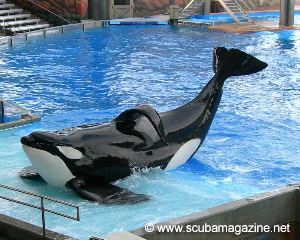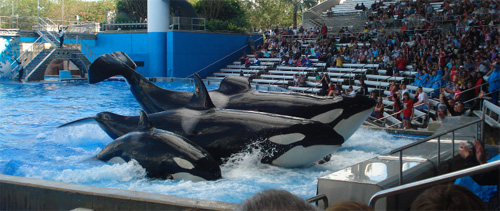Tilikum: The Slave who Fought Back
A deliberate act of retaliation, say experts
The Big Business of DolphinsPart 2 of “Dolphins & Us“ The Business of Dolphins The Movie that Launched a Revolution The Real Story: Freeing Keiko Ric O’Barry: From Flipper to The Cove Tilikum: The Slave Who Fought Back Life and Death at SeaWorld The Drive Hunts Interviews & Reports “Don’t Buy a Ticket!” More about Ric O’Barry The “Spartacus” of Whales My Visit to SeaWorld A Whale of a Business The Cove NEXT: Part Three: Saving the Dolphins. See also Part One: The Smartest of Us All? |
 Tilikum’s story begins like Keiko’s, like Willy’s in the movie, like so many other of the dolphins at amusement parks around the world.
Tilikum’s story begins like Keiko’s, like Willy’s in the movie, like so many other of the dolphins at amusement parks around the world.
This magnificent animal was torn from his family in 1982 and carried off to a theme park on Vancouver Island in Canada. His life has been a nightmare ever since. For a super-intelligent, self-aware animal with an ocean range of thousands of miles, living in a tank at a theme park is like you or me being imprisoned in a hot tub for our entire lives.
Imagine, too, that the tub is sitting in a hall of mirrors. After all, dolphins use a sophisticated system of sound waves to “see” and to communicate. And in a tank at an amusement park, those sounds just bounce back at you, echoing back and forth, over and over, until you go nuts. It’s Chinese water torture with no end.
British columnist Alexander Cockburn compares Tilikum to Spartacus, and calls him “the slave whale who chose to fight back.”
“[At the theme park in Vancouver], he met his fellow slaves, Nootka and Haida,” says Cockburn. “Day after day in slave school they learned their tricks. Day after day, they did their act for the paying customers.”
And then, on February 20, 1991, the three orcas struck back at their captors. When a 20-year-old trainer slipped while riding on the head of one of the orcas, Tilikum, Nootka and Haida took turns in dragging her around the pool. Other trainers tried to catch her on a pole with a hook, but the orcas would not let them get near her. Even after they’d drowned her, they wouldn’t let anyone near her for another two hours.
It was chillingly deliberate behavior: Tilikum’s first act of revolt.
The orcas keep up their rebellion
Soon after, Tilikum and Nootka were shipped off to Orlando, Florida, where Nootka died two years later at the age of 13. (Orcas in the wild normally live into their 50s and 60s. In captivity, many of them barely survive their childhood.) Haida, the third member of the revolt, was sent to SeaWorld, San Antonio, along with her calf, Ky. Haida died in 2001. Three years later, Ky, who had clearly learned the spirit of rebellion, almost killed his trainer.
 Back in Orlando, Tilikum killed a second human – a hapless man who had climbed into SeaWorld during the night and jumped in Tilikum’s pool.
Back in Orlando, Tilikum killed a second human – a hapless man who had climbed into SeaWorld during the night and jumped in Tilikum’s pool.
That was his second killing. And then again, in February, 2010, now in his late 20’s, Tilikum struck once more – this time against trainer Dawn Brancheau.
SeaWorld portrayed Tilly’s attack on Ms. Brancheau as a freak accident. But it wasn’t. It was the deliberate third attack of a captive who’s doing what you or I would probably do in his place. There was nothing accidental about this incident.
In fact, incidents like this are not unusual. SeaWorld and the other amusement parks simply try to keep them a secret. Just two months before Tilikum killed Dawn Brancheau, another trainer was killed by a 14-year-old orca called Keto during a training session at Loro Parque on the Spanish island of Tenerife.
Two years before that, another trainer at the same park was hit by an orca who broke her arm, injured her lung, and dragged her down to the bottom of the pool. She was rescued and survived.
A year before that, in 2006, Kasatka, a 28-year-old orca, grabbed her trainer by the foot and dragged him to the bottom of the pool, then let him surface, and then dragged him back down again for another minute before releasing him, alive but injured.
There are dozens more such reports. You can read a collection of them here.
Alexander Cockburn calls it slavery, pure and simple – basically no different from the kind of entertainment that the Roman emperors devised to keep their subjects happy and subdued with plenty of “bread and circuses.”
How long will it be before the slave masters of the dolphins give up on their murky business, and, like the Coliseum of Ancient Rome, their gladiatorial rings lie in ruins? In the wake of the death of Dawn Brancheau, more people than ever have been calling for the end of the big business of theme parks like SeaWorld. And SeaWorld has been fighting a rear-guard action.
